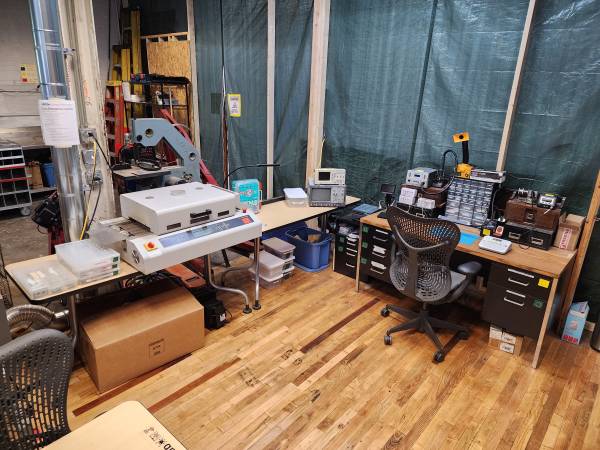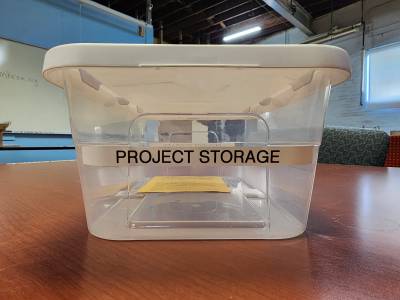Table of Contents
Electronics Orientation
The orientation for electronics has a few purposes:
- Show you where the equipment and tools are stored
- Certify you to safely use the lab space (including the yellow tools)
- Give an opportunity to ask specific questions you might have
The only thing the orientation does not cover is the use of the Gold-Flow 12 reflow oven. This is the only red tool in the space, so requires separate training to use.
Where is the electronics and lab space?
For the purposes of this orientation, the lab is the room that contains electronics, 3D printing, and laser cutting. “Electronics” occupies the space from the table the reflow oven is on to the soldering desk. The table in the middle of the lab is communal space, shared by all sections in the lab.
General Rules
- No food or drinks are permitted in the lab. This prevents you from ingesting contaminants in the room (flux, lead, printing resin).
- Don’t saw, sand, or drill into circuit boards in the lab. This creates fiberglass dust, which is harmful.
- If you have a project which requires this, the best place to do this is outside.
- Electronics does not currently have battery disposal. If you have batteries to dispose, then don’t throw them away at the space.
Project Storage
Plastic storage shoeboxes are available for project storage. The bins available for project storage are labeled “Project Storage”. All space rules must be followed when storing your projects. You must include a project storage label inside the storage bin with your project.
Things We Have
The electronics offers a few different categories of things:
- Components and project materials
- Example: resistors, capacitors, arduinos, raspberry pi’s, wire, etc.
- Soldering and repair equipment
- Examples: soldering irons, hand tools, reflow oven
- Test and Measure equipment
- Examples: multimeter, oscilloscope, power supply The sections below will talk about the specific rules for each of these categories.
Components and Project Materials
The components we have are available for you to use in your projects. - If we have a lot of a component or material, you don’t have to replace them - Example: Resistors, Capacitors - If we don’t have a lot of something or the item is expensive, then consider leaving it for the next person or returning it once you’re done with it. - Example: Arduino, Raspberry Pi - If you need it for a project, you’re also more than welcome to use it, and intend on providing a replacement later.
The spirit of the component policy is roughly like a “take a penny, leave a penny” jar. The policy is admittedly under-specified now, so if you have specific questions let me know. As the space grows I’m hoping we can all learn what works best for the space and the people using it.
When you’re done using components and materials please return them where they came from. - If you can’t remember where they live, then put them in the “to sort” bin. It’s better to put things there than in the wrong place. - We’re planning to have a parts database which will catalog available parts as well as the location they’re stored in, which will help in the future.
If there are specific components you need for a project, let me know! If it’s something that’s used a lot, we may be able to stock it. Also, we’re more than happy to accept component donations if you end up with lots of extras after a project.
Project Kits
As available, project kits will be available. Kits are available to space members who would like to do an electronics project, but need some inspiration. There are a few guidelines when using the kits:
- Don't harvest parts from a kit for other projects
Soldering and Repair Equipment
When using any of the soldering tools in the space there are a few safety rules that need to be followed. The rules here are relevant to the following tools:
- Soldering irons
- Hot air station
If you have any machine-specific questions, refer to the manual or ask.
- Use any available fume extraction. This is important both to protect yourself and to reduce the risk for other members.
- Currently the space has a benchtop fume extractor (Kotto brand, a yellow and black unit)
- You must either wear gloves or wash your hands when you’re finished soldering
- This helps prevent flux and lead contamination around the space
- Don’t leave the soldering tools on if you leave the area
- The tool should not be laid on the table when not in use. It should only either be in your hand or in the appropriate stand.
- This will protect the work surfaces in the space
- Many off the soldering tools will detect when the tool is in the stand. They will slowly cool down when in the stand, which increases the lifetime of the tool.
- For soldering irons specifically: leave some solder on the tip of the iron when you’re done
- This helps prevent oxidation on the tips.
If you're seeking to learn how to solder, this video is a good starting guide.
Test and Measure Equipment
For all tools in this category, refer to the manual for proper usage.
Oscilloscopes are currently the only yellow tools in this category. This is because of the potential to cause a ground fault.
- DON’T connect the ground leads to anything besides circuit grounded. Oscilloscope probes are grounded directly to mains. They are NOT isolated/protected, so care must be taken when taking measurements.
- If connected to any point other than ground, damage will be caused to both your project and the equipment.
Reflow Oven
Safe operation of the reflow oven isn’t covered in the general orientation. However, if something unsafe is happening (e.g. the oven is on fire or smoking), everyone is authorized to use the emergency stop switch.


